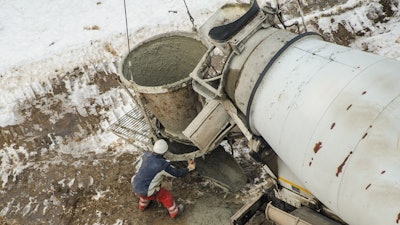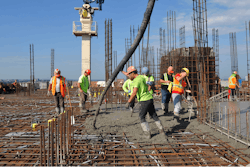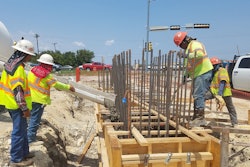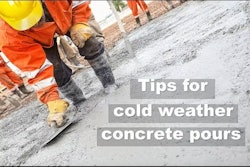
According to the ACI, concrete may be affected by, “...one or a combination of the following conditions that tends to impair the quality of freshly mixed or hardened concrete by accelerating the rate of moisture loss and rate of cement hydration, or otherwise causing detrimental results: high ambient temperature; high concrete temperature; low relative humidity; and high wind speed.” Under fair weather conditions, concrete can take anywhere from 8 to 48 hours to set properly. While concrete can reach its full strength in as little time as a week, it also takes nearly a month for it to cure properly.
However, anyone who has worked in construction before knows that weather conditions are seldom ideal.
While working with concrete may come as second nature to many contractors, it is one of the trickiest substances to work with due to how quickly it can change when exposed to different temperatures, humidity, and wind rates. The American Concrete Institute’s (ACI) technical publications are an excellent resource that provide insights regarding the plethora of effects of environmental factors on concrete. The ACI covers a variety of subtopics, ranging from extreme temperatures, humidity levels, wind velocity, natural disasters, saltwater, and freshwater’s effects on concrete in order to give contractors and concrete industry professionals accurate and up-to-date information.
Heat
The ACI’s (305.1 - 14 Hot Weather Concreting) specifications for setting and mixing concrete in hot weather suggests contractors should try to limit the maximum concrete temperature to 95º F. Contractors should ideally aim to work with, or pour, concrete when it is anywhere from 50-60º F. Under fair weather conditions, concrete can take anywhere from 8 to 48 hours to set properly. While concrete can reach its full strength in as little time as a week, it also takes nearly a month for it to cure properly.
However, anyone who has worked in construction before knows that weather conditions are seldom ideal, which is why contractors must have a firm understanding of the effects of hot weather on concrete structures and how to use weather to their advantage. For example, concrete is known to set quicker in hot weather when compared to cold weather. This is because moisture found in freshly poured concrete evaporates at a quicker rate in hot weather and subsequently allows for a faster setting time.
Due to the rapid evaporation of moisture, concrete that is poured during warm weather conditions is also more likely to experience cracks. Concrete will also be prone to more cracks if it is poured in a location where the weather cools down quickly during the night. Because of these effects, concrete that is poured and cured in 75º F weather will likely outperform concrete that is poured and cured in 100º F weather. Simply put, timing and background knowledge are absolutely crucial when it comes to working with concrete in warm weather.
Cold
Cold weather, according to the ACI 306 - “Guide to Cold Weather Concreting”, is defined as three continuous days of low temperatures, specifically below 40º F. Additionally, the ACI also considers air temperatures below 50º F for more than 12 hours as “cold weather.”
Unlike working with concrete in hot weather, where certain warm temperatures can be used to a contractor’s advantage, colder temperatures can be detrimental to newly poured concrete.
When a concrete powder is mixed with water, an immediate chemical reaction will occur which results in an internal crystallization of the concrete. These crystals make it possible for concrete to withstand additional pressure that may be caused by frozen water molecules within the concrete. Crystals will continue to grow for an extended period of time, even in cold weather. However, if temperatures drop below 15º they will no longer grow and the concrete will not cure at its full compressive strength.
Under ideal weather conditions, concrete can attain a minimum compressive strength of roughly 500 lbs. per square inch in as little as 24 hours. This is much harder to achieve in colder climates, so contractors have learned industry tricks to “fool” the concrete into thinking it’s in warmer conditions so it will ultimately cure faster.
The ultimate contractor rule when working with concrete in cold weather: Never pour concrete directly onto frozen or thawed ground space. The frozen ground will actually settle as it thaws. Because of this, concrete that is poured in very cold temperatures could also be susceptible to cracking, similar to working with concrete in warmer climates.
Wind
The ACI also states that wind velocity can affect freshly poured concrete by allowing too much water or moisture to evaporate from the concrete’s surface at a fast rate. In fact, the ACI technically classifies high wind velocity under hot weather due to the similar excessive loss of moisture concrete can experience when poured in warmer temperatures.
When concrete is poured during extremely windy weather, the rapid velocity of air will only contribute to excess moisture evaporating from the slab of concrete. Because of this, the abrasion resistance and curing condition of concrete will subsequently suffer.
Colder winds can produce what’s called a “wind chill,” which can strip excess heat from concrete. Additionally, plastic shrinkage cracking can occur when the surface of concrete dries before it has fully cured. To combat wind chill, it isn’t uncommon for contractors to turn to heaters to aid the curing process. Contractors can also use sealers to protect concrete from climates below 50º F.
Concrete is a delicate material. Unbeknownst to many people, it is not only affected by extreme temperatures, but also by humidity levels, as well as the velocity and intensity of the wind. Working with concrete demands skill and patience. It requires both the expertise of those working with concrete, as well as the cooperation of environmental factors in order to produce a smooth, strong, properly cured structure.
About the author
Matt DiBara is a fourth-generation mason of DiBara Masonry and the creator of The Undercover Contractor, a resource for educating homeowners on how to find, vet, hire and manage contractors. He has his team have become committed to ending miseducation and debunking myths that are spread to everyday homeowners. He has worked on some of the most prestigious and well-known celebrity homes in the city of Los Angeles, in addition to restoring several of Hollywood's most famous cultural landmarks. Matt is passionate about educating homeowners and empowering them with in-depth industry insight.
References
ACI 306, https://www.concrete.org/store/productdetail.aspx?ItemID=30616&Language=English&Units=US_AND_METRIC
ACI 305 1-14, https://www.concrete.org/store/productdetail.aspx?ItemID=3051U14&Language=English&Units=US_Units



















